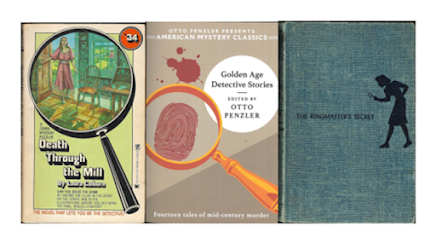Dead Man Manor (1935) by Valentine Williams
Mr. Horace "H. B." Treadgold,tailor and partner in a long-established off-Fifth Avenue establishment, has arrived at the remote French-Canadian fishing-camp of St. Florentine, ostensibly for rest and relaxation in the more out-of-the-way place he could find. In reality, a friend of his has told him of a certain Monsieur Ruffier, shop keeper and mayor of the little village, who just might have some fine old stamps that Treadgold could buy for his collection. So, he reserves a cabin at the camp--which he will share with a young doctor by the name of George Wood--and pretends interest in fishing, all the while planning to visit the village at the earliest opportunity to get a look at those stamps.
He asks for walking directions to Ruffier's shop and when told he'd better take his car rather than walk through the woods as planned. He can't understand why. Apparently, there is an abandoned house in the woods, name of Dead Man Manor, and the locals believe it to be haunted. He pooh-poohs this idea and insists on walking--the brisk exercise and fresh air is just what he needs. What he doesn't need is a nasty-looking character peering at him from the bushes while he's looking at the Manor. He learns later that the man is "One-Eye," a drunken poacher who has appointed himself the overseer of the abandoned Manor. He's sure that anyone who shows an interest in it must be plotting to take it away from its rightful owner, an absent nobleman.
It isn't long before the Manor becomes a focus of attention--to Treadgold, the young doctor, and, eventually...the police. The absent nobleman, an elderly gentleman, and his granddaughter have returned to the house (with no one the wiser), but the gentleman has a bad heart and Dr. Wood winds up treating him. He warns the granddaughter that Seigneur de Remy must stay in bed and be protected from shocks for at least three weeks, but by the next night she has sent for him again because her grandfather got out of bed and collapsed. Seigneur de Remy dies...but he isn't the only dead man in the manor. One of Treadgold's fellow campers, a man named Adams who had a run-in with the drunken tramp, is found dead in another part of the house--stabbed with a triangular-shaped instrument. More deaths follow and as the local officials focus on the poacher as suspect and a young detective from Quebec casts his suspicions on the granddaughter and the de Remy's (either separately or in cahoots), Treadgold suspects that someone else may be subtly directing the official investigation. So, Treadgold decides to conduct his own investigation.
It took me a little bit to get into this one. The opening descriptions of Treadgold, the fishing camp, the locals, and fellow campers are all very good and interesting. And the first chapter or so would make a fine traditional novel. But then he seems to be going for a gothic, spooky vibe here (speaking of the doctor once he hears about the haunted house):
A haunted house! He'd have to see that!...It was dusk and already the bats were skimming between the trees.
Further description of the abandoned house and the dark woods surrounding it, give a definite ghost story feel. It's like Williams wasn't quite sure what he wanted to write yet. Once he settles down to a good, old-fashioned mystery, he does a very good job. There are definitely clues for an observant reader to pick up (I didn't get them all, but I got enough to spot the villain of the piece). Treadgold makes for an intelligent and likeable amateur detective. At one point he strikes a very Holmesian note: pipe, dressing gown, and telling Dr. Wood not to talk to him. "I'm not fit for human society tonight!" This, just before he sits down for a really long think about the case. The romance between Dr. Wood and Mademoiselle de Remy is handled well--integrated into the mystery nicely so it doesn't seem extraneous. Oh and those stamps? You might keep them in mind if you track this one down and decide to read it. ★★★ and 1/2
First line: The peace of the warm July afternoon rested over the fishing-camp like a benediction....this case puts me in mind of going out to post a letter in a London fog. You stumble along to the letter-box at the corner of the square and when you look for your house again, hey, presto! it's gone. Dim figures loom up--you stop one and find it's somebody who's lost his bearings the same as you. You step aside to avoid a lamp-post and lo and behold! it's a policeman trying to locate his surroundings; you politely address a tall shape confronting you and it's a tree...Now I'm groping in the fog again...all the time I've the sensation that somewhere close at hand, towering through the fog, is a presence, unseen but fully realized... (Mr. Treadgold; p. 197)
Mr. Treadgold chuckled, "I've had all manner of odd experiences in my life," he observed humorously, "but I cannot recall ever having been kissed by a policeman before!" (p. 260)
Last line: With that he closed the book and turned his face, kindly and wise, toward the verandah.
**************
Deaths = 6 deaths [one neck broken; one heart attack; one stabbed; two drowned; one strangled]
.jpg)

.jpg)
.jpg)










